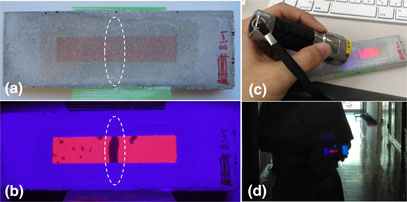Article contents
Optical microcrack sensor paints inspired by luminescent oxygen quenching phenomenon
Published online by Cambridge University Press: 29 April 2019
Abstract

Luminescent oxygen sensor composed of platinum-porphyrin and a gas-permeable polymer binder was applied as an optical crack sensor paint for infrastructure. The sensor paints were designed as a three-layered structure in which the luminescent oxygen sensor layer was sandwiched between oxygen barrier layers. The sensor paints emitted intense luminescence under UV light irradiation, and the luminescence was efficiently quenched when a new crack formed on the concrete surface. Microcracks, which were <0.1 mm width and hardly visible to the naked eye, were clearly visualized under UV light irradiation due to the luminescent quenching caused by oxygen diffusion.
Information
- Type
- Research Letters
- Information
- Copyright
- Copyright © Materials Research Society 2019
References
2.ISO: ISO 19338 Performance and assessment requirements for design standards on structural concrete, 12 (2003).Google Scholar
3.Road Maintenance in Japan; Problems and Solutions: Ministry of Land, Infrastructure, Transport and Tourism, Japan. http://www.mlit.go.jp/road/road_e/pdf/RoadMaintenance.pdf (accessed November 29, 2018).Google Scholar
4.James, S.L., Adams, C.J., Bolm, C., Braga, D., Collier, P., Friscic, T., Grepioni, F., Harris, K.D.M., Hyett, G., Jones, W., Krebs, A., Mack, J., Maini, L., Orpen, A.G., Parkin, I.P., Shearouse, W.C., Steed, J.W., and Waddell, D.C.: Mechanochemistry: opportunities for new and cleaner synthesis. Chem. Soc. Rev. 41, 413 (2012).Google Scholar
5.Kenry, , Yeo, J.C., and Lim, C.T.: Emergin flexible and wearable physical sensing platforms for health care and biomedical applications. Microsyst. Nanoeng. 2, 16043 (2016).Google Scholar
6.White, S.R., Sottos, N.R., Geubelle, P.H., Moore, J.S., Kessler, M.R., Sriram, S.R., Brown, E.N., and Viswanathan, S.: Autonomic healing of polymer composites. Nature 409, 794 (2001).Google Scholar
7.Burnworth, M., Tang, L., Kumpfer, J.R., Duncan, A.J., Beyer, F.L., Fiore, G.L., Rowan, S.J., and Weder, C.: Optically healable supramolecular polymers. Nature 472, 334 (2011).Google Scholar
8.Capadona, J.R., Shanmuganathan, K., Tyler, D.J., Rowan, S.J., and Weder, C.: Stimuli-responsive polymer nanocomposites inspired by the sea cucumber dermis. Science 319, 1370 (2008).Google Scholar
9.Sagara, Y., Yamane, S., Mitani, M., Weder, C., and Kato, T.: Mechanoresponsive luminescent molecular assemblies: an emerging class of materials. Adv. Mater. 28, 1073 (2016).Google Scholar
10.Caruso, M.M., Davis, D.A., Shen, Q., Odom, S.A., Sottos, N.R., White, S.R., and Moore, J.S.: Mechanically-induced chemical changes in polymeric materials. Chem. Rev. 109, 5755 (2009).Google Scholar
11.Wang, X.D. and Wolfbeis, O.S.: Optical methods for sensing and imaging oxygen: materials, spectroscopies and applications. Chem. Soc. Rev. 43, 3666 (2014).Google Scholar
12.Liu, T. and Sullivan, J.P.: Pressure and Temperature Sensitive Paints (Springer, Berlin, 2005).Google Scholar
13.Amao, Y.: Probes and polymers for optical sensing of oxygen. Microchim. Acta 143, 1 (2003).Google Scholar
14.Wang, L., Zhang, H., Zhou, X., Liu, Y., and Lei, B.: Preparation and characterization of a luminescent carbon dots grafted CaSiO3:Eu3+ phosphor for ratiometric fluorescent oxygen sensing. RSC Adv. 6, 98554 (2016).Google Scholar
15.Quaranta, M., Borisov, S.M., and Klimant, I.: Indicators for optical oxygen sensors. Bioanal. Rev. 4, 115 (2012).Google Scholar
16.MacLachian, B.G. and Bell, J.H.: Pressure-sensitive paint in aerodynamic testing. Exp. Therm Fluid Sci. 10, 470 (1995).Google Scholar
17.Hyakutake, T., Kato, J., Taguchi, H., Watanabe, M., and Nishide, H.: Luminescent multi layered polymer coating for simultaneous detection of oxygen pressure and temperature. Macromol. Chem. Phys. 210, 1230 (2009).Google Scholar
18.Sakaue, H., Hayashi, T., and Ishikawa, H.: Luminophore application study of polymer-ceramic pressure-sensitive paint. Sensors 13, 7053 (2013).Google Scholar
19.Inukai, J., Miyatake, K., Takada, K., Watanabe, M., Hyakutake, T., Nishide, H., Nagumo, Y., Watanabe, M., Aoki, M., and Takano, H.: Direct visualization of oxygen distribution in operating fuel cells. Angew. Chem. Int. Ed. 47, 2792 (2008).Google Scholar
20.Inukai, J., Miyatake, K., Ishigami, Y., Watanabe, M., Hyakutake, T., Nishide, H., Nagumo, Y., Watanabe, M., and Tanaka, A.: In situ and real-time visualisation of oxygen distribution in DMFC using a porphyrin dye compound. Chem. Commun. 0, 1750 (2008).Google Scholar
21.Hyakutake, T., Ishigami, Y., Kato, J., Inukai, J., Miyatake, K., Nishide, H., and Watanabe, M.: Luminescent oxygen-sensory polymer coating composed of platinumporphyrin and polytrimethylsilylpropyne for real-time visualization in operating polymer electrolyte fuel cells. Macromol. Chem. Phys. 212, 42 (2011).Google Scholar
22.Nagai, K., Masuda, T., Nakagawa, T., Freeman, B.D., and Pinnau, I.: Poly[1-(trimethylsilyl)-1-propyne] and related polymers: synthesis, properties and functions. Prog. Polym. Sci. 26, 721 (2001).Google Scholar
23.Masuda, T., Isobe, E., Higashimura, T., and Takada, K.: Poly[1-(trimethylsilyl)-1-propyne]: a new high polymer synthesized with transition-metal catalysts and characterized by extremely high gas permeability. J. Am. Chem. Soc. 105, 7473 (1983).Google Scholar
24.Duan, S., Kai, T., Saito, T., Yamazaki, K., and Ikeda, K.: Effect of cross-linking on the mechanical and thermal properties of poly(amidoamine) dendrimer/poly(vinyl alcohol) hybrid membranes for CO2 separation. Membranes (Basel) 4, 200 (2014).Google Scholar
25.Japan Society of Civil Engineering: JSCE K-532-2010 Crack elongation test methods for surface coating material (2010).Google Scholar
26.MacCraith, B.D., MacDonagh, C.M., O'Keeffe, G., Keyes, E.T., Vos, J.G., O'Kelly, B., and MacGilp, J.F.: Fibre optic oxygen sensor based on fluorescence quenching of evanescent-wave excited ruthenium complexes in sol–gel derived porous coatings. Analyst 118, 385 (1993).Google Scholar
27.Japan Society of Civil Engineers: Guidelines for Concrete, Standard Specifications for Concrete Structures − 2013 “Maintenance”.Google Scholar
- 2
- Cited by

